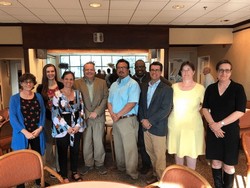Seven Buildings on Campus to Have Solar Panels Installed
 The University has announced its plan to install solar panels on seven campus buildings through a Power Purchase Agreement (PPA) before the end of the year.
The University has announced its plan to install solar panels on seven campus buildings through a Power Purchase Agreement (PPA) before the end of the year.
“Monmouth University is committed to being a national leader in sustainable energy and will continue to implement programs to create a more energy efficient and environmentally responsible environment for our students and employees,” said President Paul G. Gaffney II in a recent press release.
“I think this is a really good idea,” senior Maria Ferrara said. “We’re always talking about looking forward and going green. This is a good step for us.”
According to Vice President of Administrative Services, Patricia Swannack, the panels will be installed on Edison Science Hall, Howard Hall, Magill Commons, McAllan Hall, the Guggenheim Library, Multipurpose Activity Center and Plangere Center.
“We are still finalizing the installation schedule, but we hope to get started before the end of this year,” Swannack said.
The plan to put in solar panels was instituted by Swannack and her staff of energy advisors. ProTech Energy Solutions and their partner Torcon Inc. will install the panels with no charge to the University due to the Power Purchase Agreement.
“The solar panels will be installed through a PPA (Power Purchase Agreement) program with Torcon at no upfront cost to the University,” Swannack said. “Torcon owns, designs, installs, and operates the system for an agreed upon term. The University buys the power produced at a rate below the utility rate.”
The necessary steps to make this happen have been done to enforce the University’s concern for the environment.
“Save costs first, be green next,” said Gaffney. “I believe I have written to several NJ Governors about this—that when future leaders (students) see good energy and sustainability practices, they carry the lessons with them through life.”
“It’ll save money and it’s going to help us too,” said James Carney, a sophomore. “It’s not going to cause a negative effect on the environment. We’re not waiting for things to get bad.”
 In addition to installing solar panels, the University has had the six buildings coated with EPOXZ. EPOXZ is a “cool roof coating which provides a highly effective barrier to the sun’s heat and UV rays and leads to a reduction of interior temperatures and cooling costs,” according to a press release.
In addition to installing solar panels, the University has had the six buildings coated with EPOXZ. EPOXZ is a “cool roof coating which provides a highly effective barrier to the sun’s heat and UV rays and leads to a reduction of interior temperatures and cooling costs,” according to a press release.
“Following careful analysis, these roofs were selected for the solar installation based upon the area available to maximize the number of panels and their exposure to the sun. The coatings were installed to prepare the roofs for the solar panels and to act as a barrier to the sun’s heat and ultraviolet rays,” Swannack said. “The coatings also provide heat reduction inside the buildings to further reduce the costs of cooling the buildings.”
As of now, there are no plans to coat any other buildings with EPOXZ.
“The University is continuously investigating and implementing ways to save energy and reduce operating costs,” Swannack said. “At this time, there is no formal plan, however, we are investigating other appropriate roof locations for this coating on campus.”
Since 2005, the university has had solar panels operating on four buildings, which gave it the largest solar panel system of any university “east of the Mississippi,” according to the Asbury Park Press
The University’s environmental and green energy awareness made it the first independent university in New Jersey to sign a green operation agreement with the U.S. Environmental Protection Agency in 2009.
“The purpose of this EPA Memorandum of Understanding is to document Monmouth University’s commitment as an environmental steward who pledges to reduce its carbon footprint and generally contribute to a better environment by collaborating with the United States Environmental Protection Agency,” Swannack said.
Since the agreement, the EPA has noted that the University has decreased its carbon footprint by 11,299 metric tons of Carbon Dioxide Equivalents, which is comparable to removing 2,160 vehicles from the road for a year, according to a press release.
“The installation of the solar panels will benefit the students and the school in cost control. I hope it makes a lasting impression on future leaders – our students,” Gaffney said. “Someday our students will be making energy decisions for their families and companies. I hope that these investments at MU will be good examples for them to remember when they are making choices.”
PHOTO COURTESY of freecleansolar.com/solarpower.php


